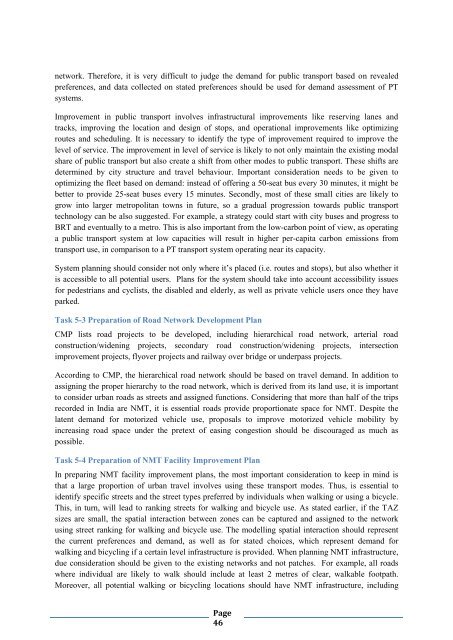Toolkits for Urban Transport Development - UNEP
Toolkits for Urban Transport Development - UNEP
Toolkits for Urban Transport Development - UNEP
You also want an ePaper? Increase the reach of your titles
YUMPU automatically turns print PDFs into web optimized ePapers that Google loves.
network. There<strong>for</strong>e, it is very difficult to judge the demand <strong>for</strong> public transport based on revealed<br />
preferences, and data collected on stated preferences should be used <strong>for</strong> demand assessment of PT<br />
systems.<br />
Improvement in public transport involves infrastructural improvements like reserving lanes and<br />
tracks, improving the location and design of stops, and operational improvements like optimizing<br />
routes and scheduling. It is necessary to identify the type of improvement required to improve the<br />
level of service. The improvement in level of service is likely to not only maintain the existing modal<br />
share of public transport but also create a shift from other modes to public transport. These shifts are<br />
determined by city structure and travel behaviour. Important consideration needs to be given to<br />
optimizing the fleet based on demand: instead of offering a 50-seat bus every 30 minutes, it might be<br />
better to provide 25-seat buses every 15 minutes. Secondly, most of these small cities are likely to<br />
grow into larger metropolitan towns in future, so a gradual progression towards public transport<br />
technology can be also suggested. For example, a strategy could start with city buses and progress to<br />
BRT and eventually to a metro. This is also important from the low-carbon point of view, as operating<br />
a public transport system at low capacities will result in higher per-capita carbon emissions from<br />
transport use, in comparison to a PT transport system operating near its capacity.<br />
System planning should consider not only where it’s placed (i.e. routes and stops), but also whether it<br />
is accessible to all potential users. Plans <strong>for</strong> the system should take into account accessibility issues<br />
<strong>for</strong> pedestrians and cyclists, the disabled and elderly, as well as private vehicle users once they have<br />
parked.<br />
Task 5-3 Preparation of Road Network <strong>Development</strong> Plan<br />
CMP lists road projects to be developed, including hierarchical road network, arterial road<br />
construction/widening projects, secondary road construction/widening projects, intersection<br />
improvement projects, flyover projects and railway over bridge or underpass projects.<br />
According to CMP, the hierarchical road network should be based on travel demand. In addition to<br />
assigning the proper hierarchy to the road network, which is derived from its land use, it is important<br />
to consider urban roads as streets and assigned functions. Considering that more than half of the trips<br />
recorded in India are NMT, it is essential roads provide proportionate space <strong>for</strong> NMT. Despite the<br />
latent demand <strong>for</strong> motorized vehicle use, proposals to improve motorized vehicle mobility by<br />
increasing road space under the pretext of easing congestion should be discouraged as much as<br />
possible.<br />
Task 5-4 Preparation of NMT Facility Improvement Plan<br />
In preparing NMT facility improvement plans, the most important consideration to keep in mind is<br />
that a large proportion of urban travel involves using these transport modes. Thus, is essential to<br />
identify specific streets and the street types preferred by individuals when walking or using a bicycle.<br />
This, in turn, will lead to ranking streets <strong>for</strong> walking and bicycle use. As stated earlier, if the TAZ<br />
sizes are small, the spatial interaction between zones can be captured and assigned to the network<br />
using street ranking <strong>for</strong> walking and bicycle use. The modelling spatial interaction should represent<br />
the current preferences and demand, as well as <strong>for</strong> stated choices, which represent demand <strong>for</strong><br />
walking and bicycling if a certain level infrastructure is provided. When planning NMT infrastructure,<br />
due consideration should be given to the existing networks and not patches. For example, all roads<br />
where individual are likely to walk should include at least 2 metres of clear, walkable footpath.<br />
Moreover, all potential walking or bicycling locations should have NMT infrastructure, including<br />
Page<br />
46
















